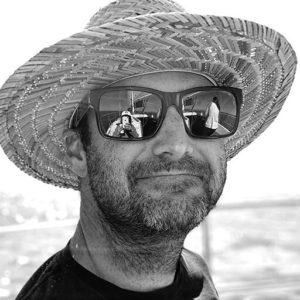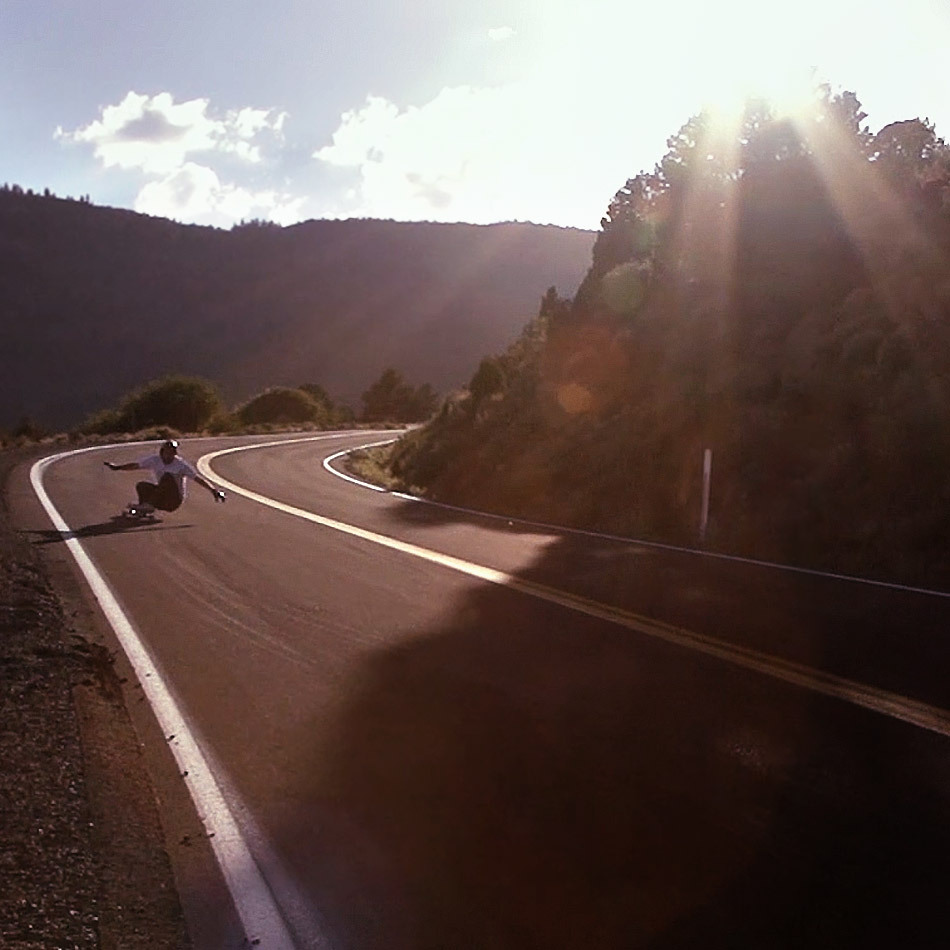Part 1: Some Context
Downhill Skateboarding: A Brief Explanation
The expression “downhill skateboarding” generally conjures images of someone straight-lining down a long, steep hill, racing to reach the bottom before their speed eclipses the integrity of their equipment. Almost everyone has that hill in their neighborhood known for its steep grade and direct threat to manual transmissions, and maybe they even bombed it once or twice in high school. But in reality, Downhill Skateboarding is much more technical.
The best in the sport tend to favor more mountainous environments, quiet roads that stretch on for miles with a mix of chicanes and hairpin corners. The true measure of a good rider is not how fast they can go in a straight line, but how they navigate these features with a combination of speed, flow, and style. And in 2014, James Kelly was arguably the best in the world in all three categories.
James Kelly
James had already been in the downhill scene for almost a decade when we started working together. He was one of the first to look stylish going over 40mph and instrumental in the sport’s progression.
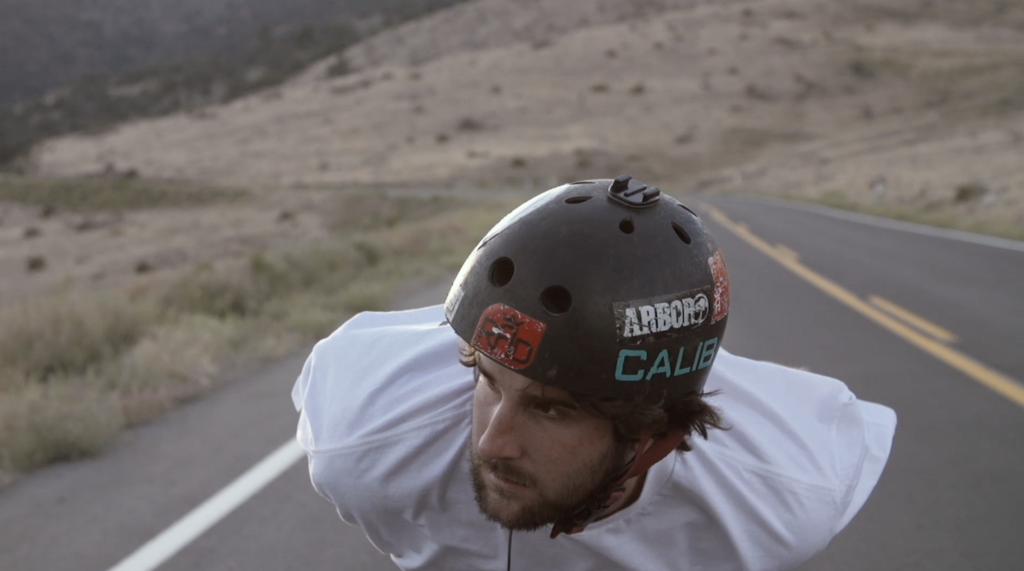
Growing up north of San Francisco, he would often travel to his family’s cabin on Pinecrest Lake, a 45-minute drive from the base of the Sierra Nevada mountain range. It was in this area that he began to really hone his downhill skills and experiment with speed control in ways that would eventually transform the sport. Even when he moved to LA, he would always return to the cabin a few times a year. His connection to those mountains is as much spiritual as it is adrenaline based.
The Concept
Early in the summer of 2014, Arbor tapped me to shoot a release video for the new James Kelly Pro Model skateboard. Surprisingly, up to that point, James had never had a board with his name on it, so this was a big deal for him. When the graphic was revealed to us – a log cabin on fire – we both immediately knew we were headed to Pinecrest.
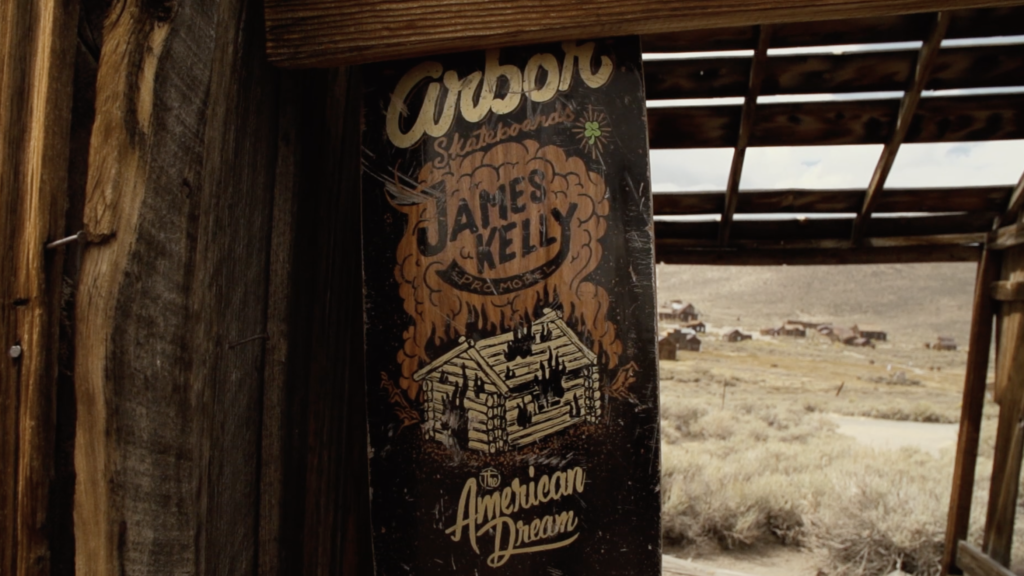
At the time, I never really bothered with outlining ideas or exploring concepts in pre-production. I always felt that this was an extreme sport, no reason to dress it up, and even if we did, the core viewership wouldn’t like it or wouldn’t notice.
On top of that, budgets were tight; gas was covered, maybe a few bucks for food, and a fixed rate to shoot and edit each piece. So, our approach was the same as any other shoot: drive out to the mountains, capture a bunch of high-speed hill bombing, and grab a few b-roll shots to pad and break up the pace of the edit.
Part 2: The Crash
Day One
The first morning we got up at dawn and drove for a couple of hours out to Tioga Pass. Tioga is more of a speed hill, meaning there aren’t any sharp corners to speak of, so you can essentially lock into a tuck and stay that way as long as your legs will let you. We filmed for a few hours, over which James touched 50mph a handful of times, and executed one particularly radical heelside powerslide in a roadside pullout.
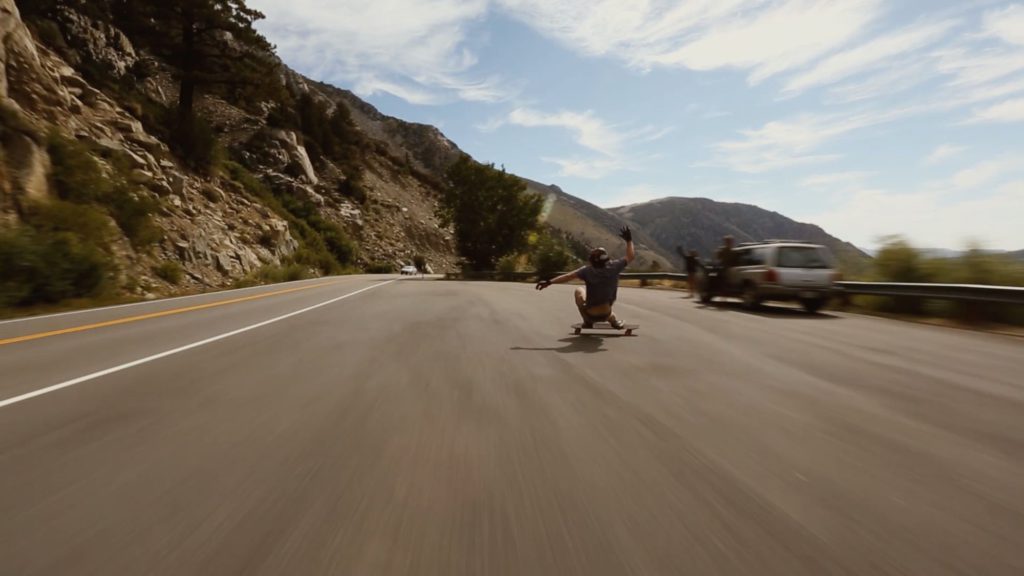
After Tioga, we drove out to an old ghost town called Bodie National Park – we thought it’d make a cool backdrop for some shots of the board. But, with no plan after wandering around for an hour feeling uninspired, we abandoned the idea and left to film more skating. James had another hill in mind, Monitor Rd, that had some tighter corners and a long straightaway at the bottom that he was eager to film. We met a friend in the valley, a gentleman who goes by “Chubbs”, and the three of us headed up the hill.
The plan was to do a few car-mount follow runs of the entire hill and then get out the tripod and film our way down with some stationary setups on some of the road features we wanted to highlight. James expertly threaded his way through the windier section of the road and when we hit the straightaway he went into a tuck to pick up as much speed as possible. And then he just kept accelerating.
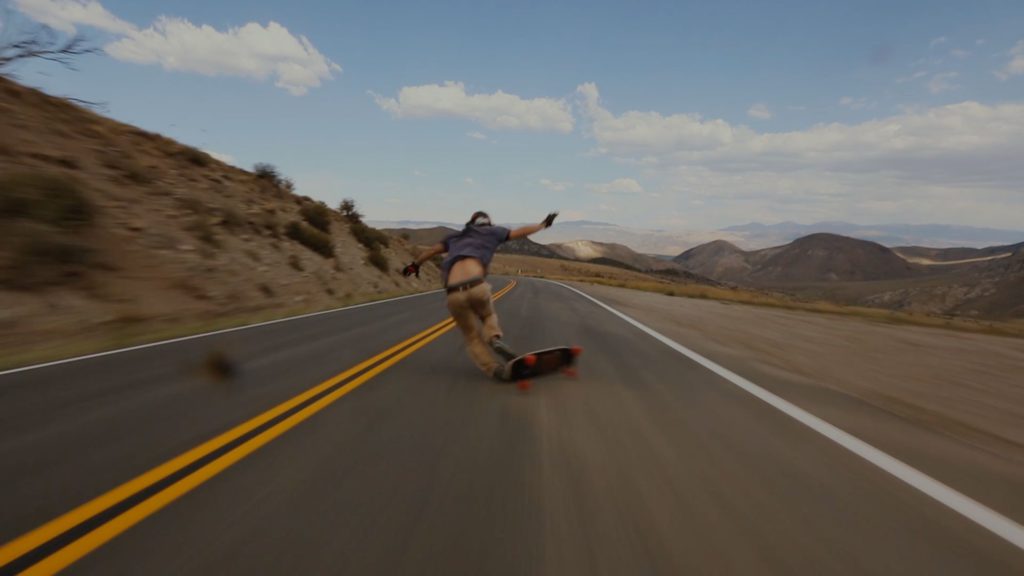
The last thing I remember is glancing down in time to see my speedometer cross 60MPH with no signs of leveling out. It was the fastest I’d ever seen anyone go by a lot – and it was scary. It felt like we realized what was happening almost in unison because as soon as I started thinking we had flown too close to the sun, James rose out of his tuck in an attempt to slow himself down by air breaking. But even a tiny shift in weight at that speed was enough to send a wave of speed wobbles through his board, and an instant later he was careening headfirst toward the pavement. To his credit, he managed to lift himself onto his pucks and the toes of his shoes fairly quickly to ride out the inertia, but just grazing the pavement for a split second at that speed is enough to do very significant damage.
To my relief, he stood up immediately. We were both pretty shaken. There’s a shot in the video right after he falls where you can see blood dripping off his foot, and that was blind luck. I was filming while Chubbs was patching James up. When Chubbs peeled his pants back, the damage to his knee was so significant I put the camera down to help hold the gauze in place while Chubbs ran back to his truck for more. In my haste, I forgot to stop recording and, by sheer luck, rendered this bizarre frame of his feet that subtly hints at his injuries.
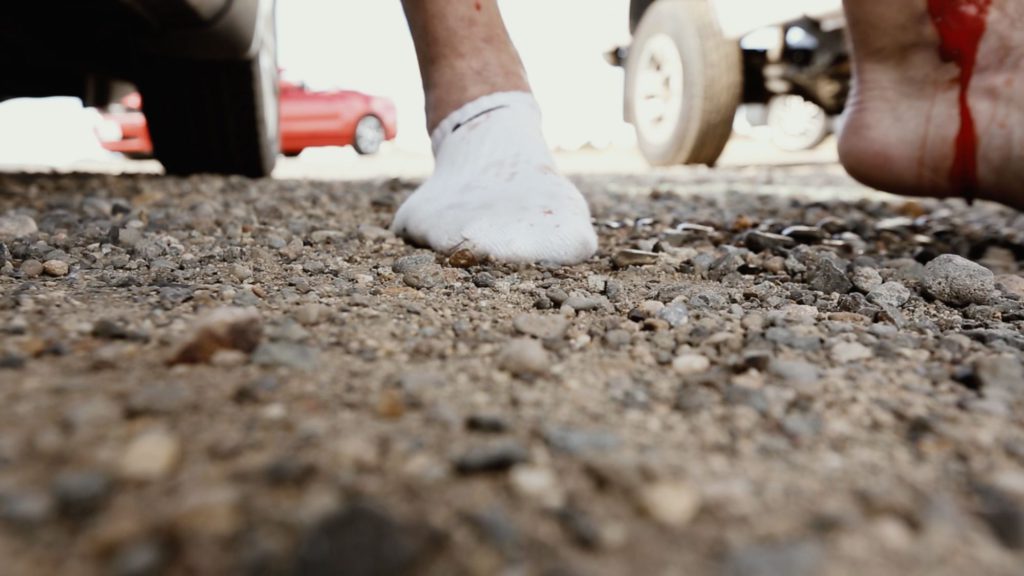
Dream Sequence?
We called Arbor and told them the shoot was done and we were headed home. On the drive back, we talked about music and tried to distract James from his pain. I played him Jim by Swans, and he loved it. I figured we’d save it for the next piece we worked on together. Arbor already had some photos of James on the new board, so maybe they could center the release around those.
The next day, James called me and said we were headed back up in three weeks. He was feeling better and just needed time for the road rash to heal and the soreness to lessen. He also said he didn’t want to do just another amp edit, he wanted the piece to feel like a dream. At the time, shoots were always based around a road, or an area, or a style of riding. B-roll was always an afterthought reserved for the downtime between skating but rarely focused on otherwise – I had to admit this idea of a dream sequence intrigued me.
One big advantage I had was that our first attempt at the video had ended up acting as an extended location scout. Plus, we knew what song we wanted to use (everyone was on board with Jim), so I had a road map for the emotional peaks and valleys of the edit. Between that and James’s spectacular fall we already had in the can, enough of the puzzle was taking shape that I could start to see the other pieces we would need to finish. I don’t remember specific influences, but in retrospect it seems like I may have been pulling a lot from 2001: A Space Odyssey, whether consciously or not.
Part 3: Let’s Try This Again
Day One Redux
Driving back out to Pinecrest and the vibe in the car was even better than the first time. I had a notebook full of shot ideas and little moments to capture, James had brought two of his friends to help shuttle runs to ease my workload, and we knew exactly what we had to accomplish. We were headed to one of the most scenic and technically challenging roads in the Sierras, Sonora Pass, which would be the centerpiece of the entire film.
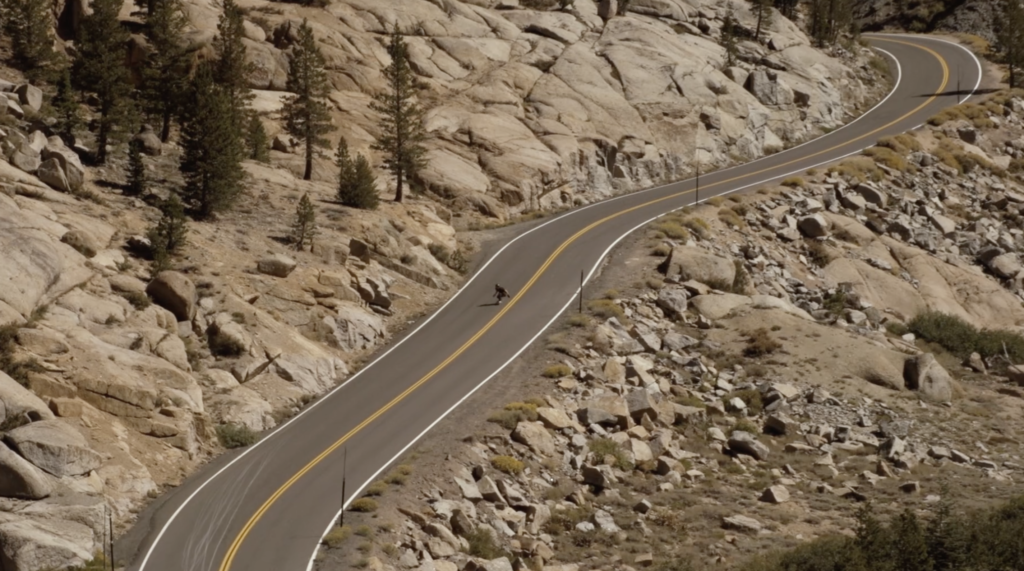
We got to the top and decided to get the car-mount run done first. James was still feeling the crash from three weeks ago, and I could tell he wanted to get this out of the way. So, I suctioned the 5d on the hood of my Subaru Outback and we went for it.
He looked good, bobbing and weaving across the pavement, executing his line with precision, all systems go. As he set up for a particularly sharp hairpin corner at the bottom of the run, he touched his gloved hand to the pavement for a split second and instantly dislocated his shoulder. He was able to avoid crashing, but we were done for at least a day, maybe more. He was frustrated, his friends were bummed, and I was frantically trying to figure out how to salvage the day.
We hit the local general store, loaded up on beer, and headed back to the cabin. James and his friends sat on the deck and listened to music while I wandered around the cabin, shuttering every window I could find until it was pitch black inside. Then I put the camera (Sony FS700) on a glide cam, opened each window one by one, and improvised little camera moves based on our idea of a dream sequence. I had a laptop with me, and I would go back to the computer every five or six shots and try editing them together with Swans playing underneath.
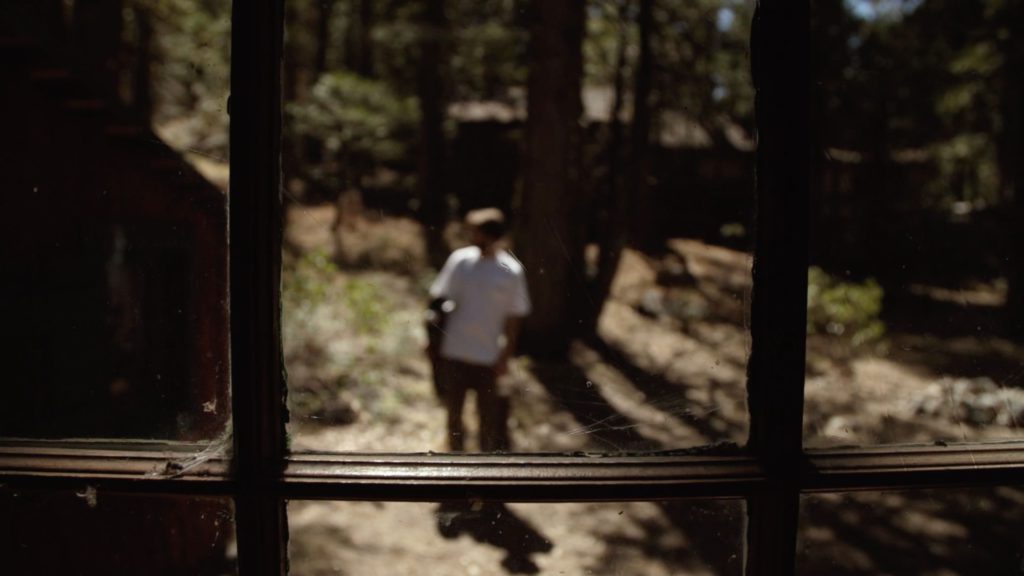
Eventually, I grabbed James and we filmed what would become the first two shots of the final edit. This ended up being a massive help because once those two shots were in the can, the puzzle started to take shape. And on top of that, it gave James an idea of what I was going for stylistically. We agreed that if we could have a productive day of skating the following day, we’d be in a good place.
More Problems
I was leaving for Australia at the end of the week, so we only had two full days left to shoot. James said his shoulder was good enough, so we headed back into the mountains, spirits rejuvenated. But, when we reached the top of Sonora, we were met by dark storm clouds and a moment later we found ourselves amid a torrential downpour.
Now we were faced with a fairly large problem. Sonora Pass was the crown jewel of the video; the whole thing revolved around James’ performance on this specific stretch of road. And even if the rain subsided relatively quickly, it could take hours, sometimes days for a road to properly dry. The only thing more dangerous to a downhill skater than wet roads are patchy roads. Pavement consistency is incredibly important at high speed and patches of wet pavement can spell disaster.
Once again, we scrubbed our plans and decided to head back to the ghost town of Bohdi to shoot more of the dream sequence. We started referring to our journey as the “cursed shoot” – somehow it improved everyone’s morale. The idea that everything that could go wrong would go wrong was strangely liberating.
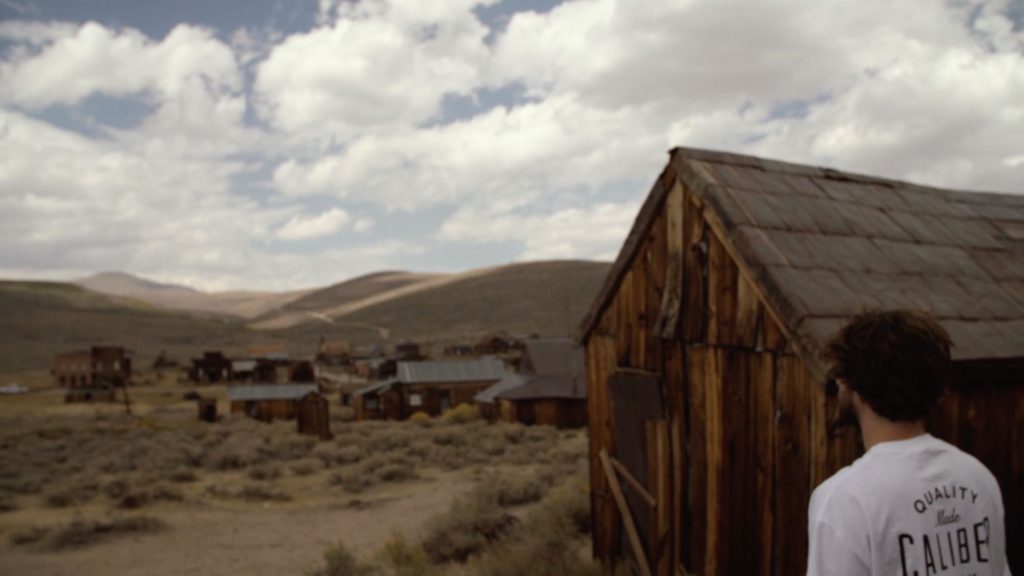
To our surprise, we were greeted with nice weather in Bodie and a beautiful sky peppered with hundreds of tiny clouds. This time I had a clear list of objectives, plus we had plenty of time to wander around and experiment with angles and framing because of the rain on Sonora. We found an old outhouse doorway to shoot the transition from the cabin. We executed the first half of the blink transition, which to this day, I have no idea where the idea came from. I wasn’t the first to do it by a long shot – and I certainly wouldn’t be the last.
After Bodie, we figured we might as well try and get the other side of the blink transition to finish the day. The only road close enough with a long enough straightaway happened to be the one James had crashes on three weeks earlier, Monitor. It was surreal driving back up. We pulled over and reenacted the crash for James’ friends. Then we went about setting up the camera so that I could film out the back of the Subaru.
The idea was James would hold onto the back until we got up to 25-30mph and then do the blink and let go. I would tilt down and rack focus as we pulled away from him. We got everything set up and then came to find out neither of James’ two friends could drive a manual transmission. Neither James nor I had even thought to ask. Luckily we were on a hill, so we just threw the car in neutral, and one of his friends steered while we coasted down.
By the time we started filming, the sun was getting low and we were losing light by the second. We tried it three times, but just executing the blink and letting go of the car was proving to be exponentially more challenging than I had imagined. The sun quickly set, so I called it and we headed back to Pinecrest.
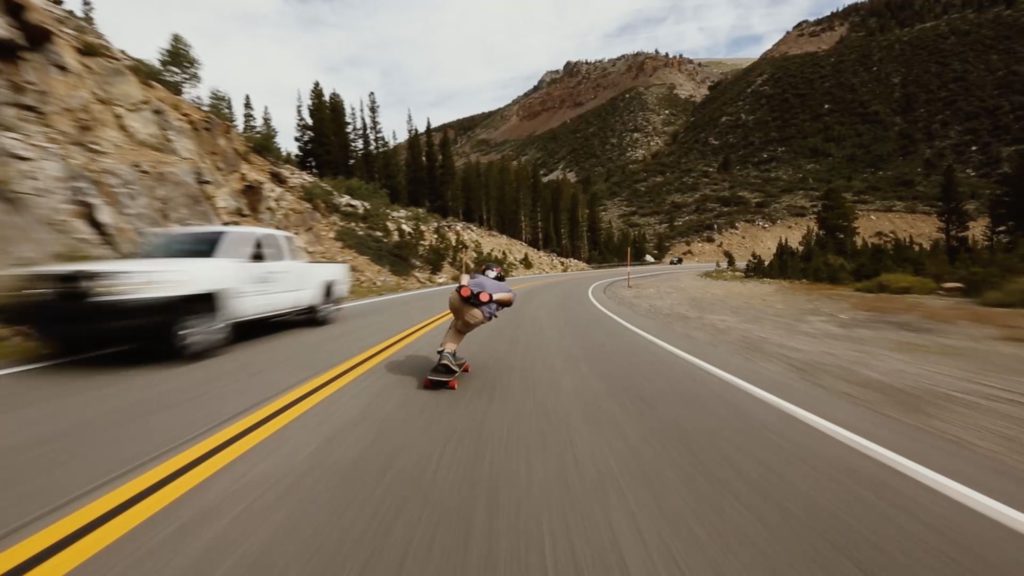
That night I went through the footage and cut the first forty-five seconds of the edit together. It looked good. We had gotten the blink, James and I both felt like it could be something special. The only problem was we had almost no skate footage and one day left to shoot. And so far, James had barely skated since his accident.
Our Luck Finally Changes, Sort Of
The next day it finally happened. Things started to go right. To our relief Sonora was dry. James skated with incredible confidence, nailing every line. We shot the follow run that closes out the film first thing in the morning – we knew we were good once we had it. We worked our way down the hill, shooting different corners that caught our eye. I even broke out my little travel jib for a few shots to mix it up.
James skated for hours through a sore shoulder and what must have been a sore body and never once complained. Because his friends couldn’t drive a manual transmission, James would drive my car up the hill after each run, turn it around so that it was pointed down the hill, and then put it in neutral so they could coast down the hill behind him. All this while, I sat with the camera on each corner, waiting to hear the sound of wheels rushing over asphalt.
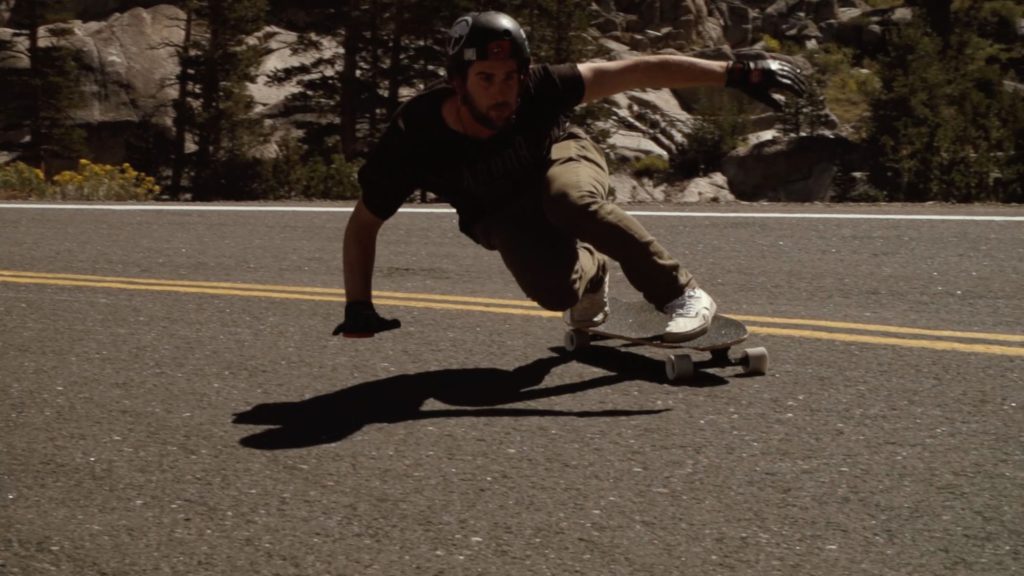
We wrapped the shoot that evening, feeling good that somehow we’d got everything we needed. Thirty minutes after leaving the cabin, my car broke down and we sat on the side of the road for two hours waiting for a tow truck. James and his friends eventually had a buddy come pick them up and I stayed behind with my car.
Part Four: Epilogue
After I returned from Australia, the post-work for Burn It Down was quick. It took about a day to edit, maybe one more to add some sound design and color grade (both done by me and neither of which is particularly impressive). Upon its release, it went what I would call “mini viral.” It got a lot of circulation, a lot of views. It was praised by the core audience. James went on TMZ to talk about the crash. Someone sent me a picture of an Irish newspaper with an article about Burn It Down in the sports section. The car company Peugeot even copied the intro for one of their commercials a few months later.
For me, it was a massive confidence boost. The idea that you could mix narrative storytelling, however vague, with an extreme sport was a huge takeaway and something that still influences my work today. And whenever I think back on the production, I can’t help but wonder if it would have turned out as good if we had not been faced with constant adversity. If James doesn’t crash, he never thinks of a dream sequence. If he doesn’t dislocate his shoulder, I don’t have a day to experiment in the cabin. If it doesn’t rain, we don’t spend extra time in Bodie, and we likely don’t shoot the blink transition right at golden hour. Heck if James isn’t injured so badly I never put the camera down and perfectly frame up his feet. But I think anyone who is passionate about filmmaking, from a big-time Hollywood director to a kid in his garage, understands that embracing that chaos is what makes filmmaking such a wonderful, meaningful, and rewarding pursuit.
